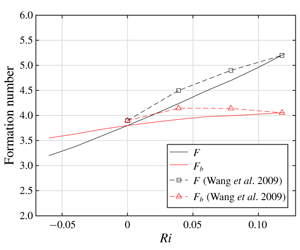Published online by Cambridge University Press: 08 January 2020

As an important dimensionless parameter for the vortex formation process, the general form of the formation time defined by Dabiri (Annu. Rev. Fluid Mech., vol. 41, 2009, pp. 17–33) is refined so as to provide better normalization for various vortex generator configurations. Our proposed definition utilizes the total circulation over the entire flow domain rather than that of the forming vortex ring alone. It adopts an integral form by considering the instantaneous infinitesimal increment in the formation time so that the effect of temporally varying properties of the flow configuration can be accounted for properly. By including the effect of buoyancy, the specific form of the general formation time for the starting forced plumes with negative and positive buoyancy is derived. A theoretical prediction based on the Kelvin–Benjamin variational principle shows that the general formation time manifests the invariance of the critical time scale, i.e. the formation number, under the influence of a source–ambient density difference. It demonstrates that the general formation time, based on the circulation production over the entire flow field, could take into account the effect of various vorticity production mechanisms, such as from a flux term or in a baroclinic fluid, on the critical formation number. The proposed definition may, therefore, serve as a guideline for deriving the specific form of the formation time in other types of starting/pulsatile flows.